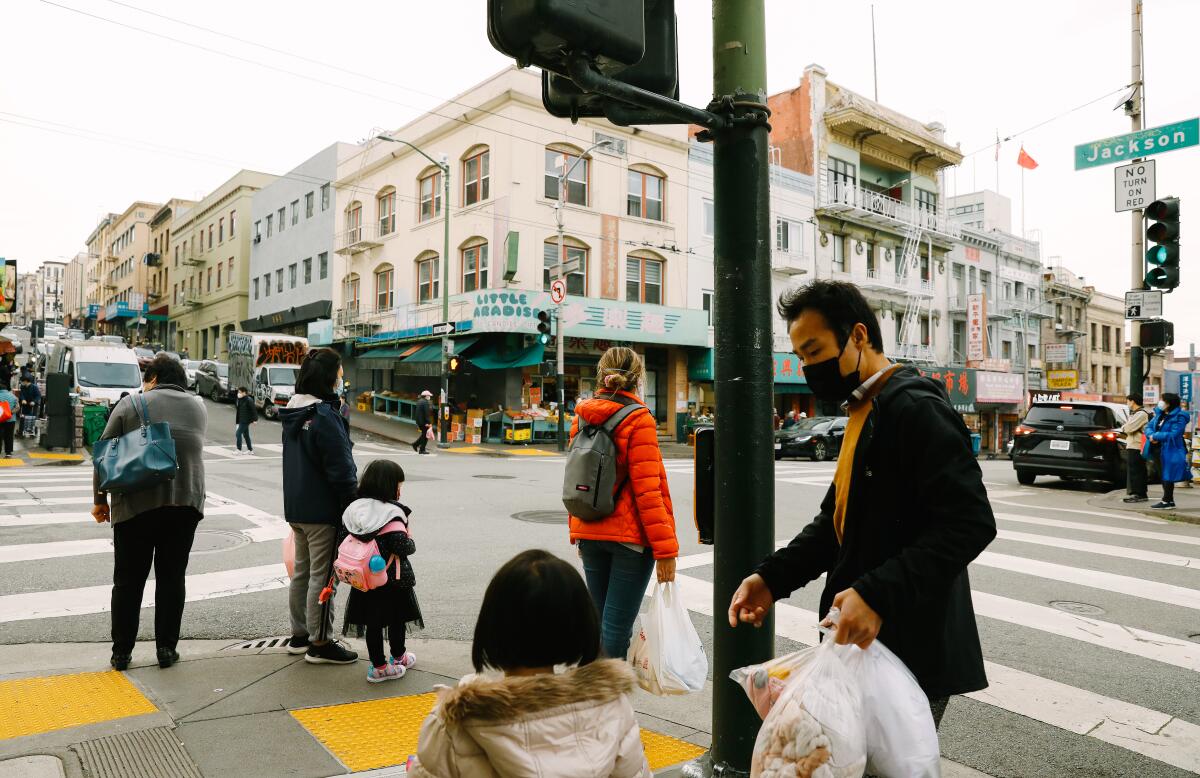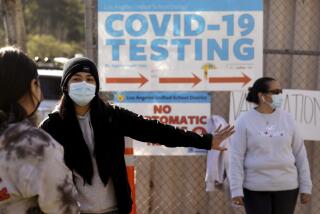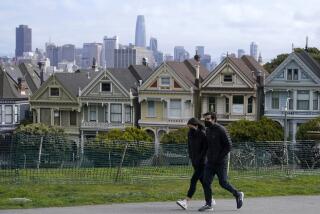San Francisco eases mask, vaccination proof rules as Omicron recedes

- Share via
SAN FRANCISCO — San Francisco will ease its COVID-19 mask order for vaccinated gym members and office workers, and will relax rules requiring proof of vaccination when entering large indoor sports arenas, restaurants, bars and gyms, allowing unvaccinated people to enter if they show proof of a recent negative test.
The move comes as the Omicron surge is flattening after weeks of record-setting infections. San Francisco has one of California’s most robust rates of vaccination and has a relatively high booster rate.
The new rules, which take effect Tuesday, will say that gym members and office workers no longer need to wear a mask indoors as long as they are up-to-date on their vaccinations and booster shot, if eligible.
The rules will allow people who are vaccinated but not yet boosted to enter these gyms and offices that offer a mask-optional policy, as long as they wear a mask.
In addition, the city will begin allowing gyms and offices to allow unvaccinated people to enter who cite a religious belief exemption or a medical reason, but they need to show proof of a recent negative coronavirus test and wear a mask when not eating or drinking or showering.
The overall mask order for San Francisco, which requires mask wearing in public indoor spaces such as supermarkets, remains in effect. San Francisco will also begin allowing unvaccinated people to enter “indoor mega-events” with 500 or more people, such as Chase Center, the home of the Golden State Warriors, as long as they show documentation of a recent negative coronavirus test.
The test can’t be a take-home test that you perform yourself; it has to be administered by a test provider and the document needs to include a person’s name. The new rule alters San Francisco’s months-old order that required operators of large indoor venues to check guests age 12 and up for proof of vaccination, which had been one of the strictest rules in the state and did not allow unvaccinated people to enter.
San Francisco will also allow — but not require — places like indoor restaurants, bars, clubs, theaters and entertainment venues to allow unvaccinated people to enter if they cite religious beliefs or a qualifying medical reason.
But they must also show a recent negative coronavirus test to enter. Those who have received their two-dose Pfizer or Moderna primary vaccination series are eligible for a booster five months after their second dose. People who got the Johnson & Johnson shot can get a booster two months after the single-dose vaccination.
San Francisco is eligible to make this tweak in its mask rules because it had a similar rule in place before California ordered a statewide mask mandate in mid-December, as the Omicron variant spread rapidly.
The state’s mask order, set to last through Feb. 15, only applied to counties that didn’t already have a local indoor mask order, such as San Diego, Orange, Riverside and San Bernardino counties.
Southern California, the San Francisco Bay Area and the Greater Sacramento area have also observed daily coronavirus case declines of roughly 25% from their Omicron peak.
Daily coronavirus cases, however, still remain high. Statewide, daily coronavirus cases are still roughly double the level of last winter’s peak.
Hospitals in Southern California still report being strained, but some systems, including Los Angeles County’s public hospitals and Kaiser Permanente Southern California, have recently said that the number of coronavirus-positive patients they are treating has either flattened or is starting to decrease.
Health officials in San Francisco have described a less severe impact on hospitals from its Omicron surge. “Fortunately, for the vast majority of our cases in the city, cases have been mild — because people were fully vaccinated with the first series, and many people were up-to-date on their vaccinations with regards to the boosters,” the San Francisco health director, Dr. Grant Colfax, said last week.
In San Francisco, 82% of residents of all ages are considered fully vaccinated, and over half of the city’s 870,000 residents — more than 451,000 people — have received a booster.
In Los Angeles County, 69% of residents are fully vaccinated. Less than one-third of the county’s 10.1 million residents — about 3 million people — have received a booster shot.
More to Read
Sign up for Essential California
The most important California stories and recommendations in your inbox every morning.
You may occasionally receive promotional content from the Los Angeles Times.











